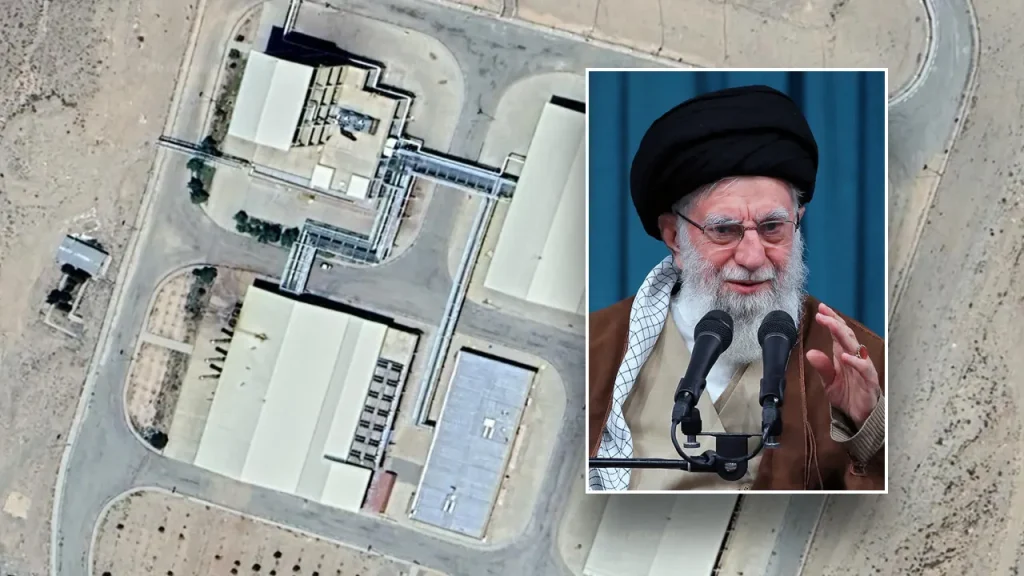In a significant development regarding Iran’s nuclear ambitions, satellite imagery has unveiled a previously undisclosed nuclear facility, raising fresh alarms amid ongoing diplomatic negotiations. The location, referred to as the “Rainbow Site,” spans nearly 2,500 acres in Iran’s Semnan Province and has operated under the disguise of a chemical production company for more than a decade. These revelations, reported by the National Council of Resistance of Iran (NCRI), imply potential advancements in Iran’s weapons program, particularly concerning the extraction of tritium, a critical isotope used in enhancing nuclear capabilities.
| Article Subheadings |
|---|
| 1) Unveiling the “Rainbow Site” |
| 2) Operational Secrets of the Facility |
| 3) Implications for U.S.-Iran Negotiations |
| 4) Official Reactions and Statements |
| 5) The Broader Impact on Global Security |
Unveiling the “Rainbow Site”
The newly named “Rainbow Site” has come to light following an intelligence report from the NCRI, which scrutinized satellite images to unearth this hidden nuclear facility. Located in Semnan Province, far removed from Iran’s publicly acknowledged nuclear installations, the complex raises significant concerns regarding the country’s nuclear ambitions. The facility covers approximately 2,500 acres and has been operational for over ten years, indicating a long-term strategic intent behind its concealment. As diplomatic efforts between Iran and the United States progress, this discovery complicates the narrative around Iran’s commitment to peaceful nuclear development.
Operational Secrets of the Facility
According to sources from the NCRI, the primary function of the Rainbow Site is the extraction of tritium, a radioactive isotope that plays a crucial role in the construction of nuclear weapons. Unlike uranium enrichment, which can have civilian applications, tritium mostly serves military purposes. The dual-use nature of nuclear technology often clouds the intentions of nations like Iran, which has repeatedly claimed that its nuclear pursuits are solely geared toward energy production. The underlying secrecy surrounding the Rainbow Site further contradicts these assertions, prompting questions about the regime’s transparency and intentions in nuclear diplomacy.
Implications for U.S.-Iran Negotiations
The revelation of the Rainbow Site comes at a critical juncture in U.S.-Iran negotiations, reigniting fears among observers of potential nuclear escalation. While discussions have been ongoing, questions remain regarding the U.S. stance on Iran’s capacity to maintain a nuclear enrichment program without veering into weapons development. Officials, including President Donald Trump, have indicated that a definitive decision on this matter has yet to be reached, with Trump emphasizing the need for careful considerations in the diplomatic talks. This tension is not just limited to negotiations but may also impact public perception of nuclear deals aimed at curbing Iran’s nuclear capabilities.
Official Reactions and Statements
Despite the alarming intelligence surrounding the Rainbow Site, U.S. officials have expressed cautious optimism about the ongoing negotiations. Vice President JD Vance noted that discussions have remained on track, highlighting a measured approach from the American side in light of the newfound intelligence. His comments suggest that while apprehension exists, there is still hope for a diplomatic resolution that acknowledges Iran’s security concerns without jeopardizing international safety. However, observers warn that the existence of the Rainbow Site could dampen the progress achieved thus far and lead to further complications in negotiations.
The Broader Impact on Global Security
The discovery of the Rainbow Site signals potential implications that extend beyond Iran and the United States. An undisclosed nuclear facility raises questions about nuclear security across the Middle East and beyond, as regional tensions persist. The presence of advanced nuclear capabilities combined with geopolitical instability can lead to an arms race, prompting other nations in the region to reconsider their security policies and nuclear strategies. The international community must evaluate how best to handle such revelations to foster a climate of stability while ensuring compliance with non-proliferation agreements.
| No. | Key Points |
|---|---|
| 1 | Satellite imagery reveals the “Rainbow Site,” a hidden nuclear facility in Iran. |
| 2 | The site has been operational for over a decade, posing questions about Iran’s nuclear intentions. |
| 3 | The facility is involved in the extraction of tritium, mainly used for nuclear weapon enhancement. |
| 4 | U.S. officials maintain a cautiously optimistic view on ongoing negotiations despite the revelations. |
| 5 | Discovery could trigger heightened tensions and an arms race in the Middle East. |
Summary
The unveiling of the Rainbow Site presents new challenges for international diplomacy regarding Iran’s nuclear program. As negotiations continue, the complexity surrounding this hidden facility underscores concerns about nuclear proliferation and regional security. The potential extraction of tritium raises alarm bells in a world already anxious about nuclear advancements in volatile regions. Ultimately, how the U.S. and its allies respond to this intelligence may very well shape the future of nuclear diplomacy in the years to come.
Frequently Asked Questions
Question: What is the significance of the “Rainbow Site”?
The “Rainbow Site” is a previously undisclosed nuclear facility in Iran that has been operational for over a decade, indicating potential advancements in Iran’s nuclear weapons program.
Question: Why is tritium extraction concerning?
Tritium is a radioactive isotope primarily used in nuclear weapons, and its extraction indicates that Iran may be pursuing military capabilities rather than solely energy production.
Question: How might this discovery affect U.S.-Iran negotiations?
The discovery of the Rainbow Site complicates U.S.-Iran negotiations by raising concerns over Iran’s nuclear intentions and may impact the ongoing diplomatic discussions aimed at limiting nuclear proliferation.
